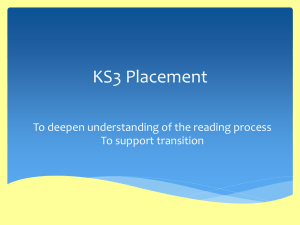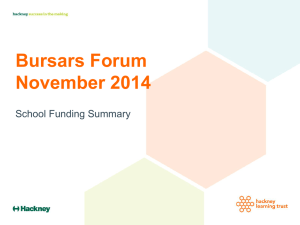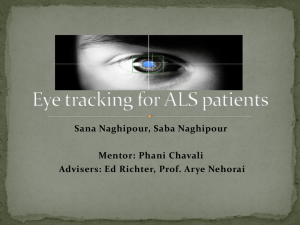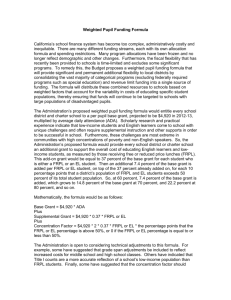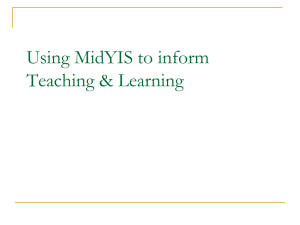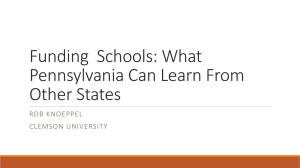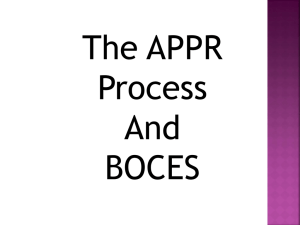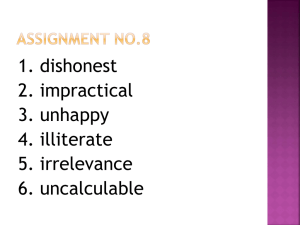Basics of State Aid - State Aid and Financial Planning Service
advertisement
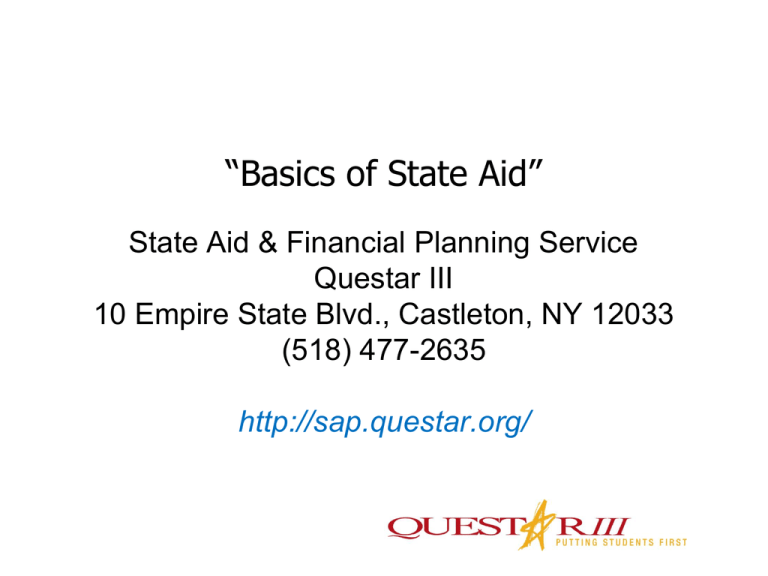
“Basics of State Aid” State Aid & Financial Planning Service Questar III 10 Empire State Blvd., Castleton, NY 12033 (518) 477-2635 http://sap.questar.org/ Agenda •Overview of Funds for Education •Local, State and Federal •State Budget Process •SAMS •State Aid Formula •Output reports In New York State, 2009-10 public education funding comes from three sources: – 7.8 percent from federal sources, – 41.7 percent from State formula aids and grants, – 50.5 percent from revenues raised locally. "Analysis of School Finances in New York State School Districts 2008-09” New York State Education Department. January 2011. Infusion of Federal Money - American Recovery and Reinvestment Act The American Recovery and Reinvestment Act (ARRA) primarily allocates funds to school districts in four ways: 1. Fiscal Stabilization Funds ($3.05b) 2. Additional IDEA (611 and 619) Grants ($393.9m) 3. Additional Title 1, Part A ($423.4m) All of the above ended in 2011 4. Education Jobs Funds ( EJF) ($608 m) EJF ends 6/30/2012 5 The Design of State Aid Poor districts receive more aid than wealthy districts. • Wealth Equalization • Determination of Fiscal Capacity • Aid Distribution Systems State Budget Process • Regents’ Proposal – Released in November – Reflects Regents’ program priorities & initiatives – Conceptual format – District by district aid projections not available State Budget Process • Executive Budget Proposal – Released in January – Reflects Governor’s priorities & fiscal condition of state – Based on projected district data for upcoming school yr. submitted with Fall state aid claim – Verify root cause of changes in aid • Formula • Estimated data State Budget Process • Final Budget Projections – Released when Governor & Legislative leaders come to an agreement on state aid to education – Formula changes drive $ to regions & priorities – Based on priorities & $ available – Timing of state budget does not coincide with district budget timelines – Projections are based on estimated data (Forms A, F & ST-3) provided by district the previous Fall State Budget Process • Final Budget Projections – Identify aid formulas with significant change and determine reason for change • Formula was modified • Estimated district data (expense, pupils) – Does projection data accurately reflect actual data – Ex. New bus purchases, increased BOCES services, actual high cost or private EC expenses for SWD – Compare the budgeted revenue to final projection Timeline For Reporting State Aid Data • July – December – Districts collect & report state aid data via State Aid Claim Forms (SAMS). – SED reports preliminary 2009-10 state aid via General Aid Output reports available on SED State Aid Unit website – SED compiles the projected data (estimates for 20010-11). Districts had until 11/1/09 to make corrections to data that will be used for legislative proposals Timeline For Reporting State Aid Data • January – April – SED, Gov & legislature use the estimated data to prepare projections for 20010-11 state aid under the Governor’s proposal, as well as the final aid projections • May – June – SED prepares State Aid Claim Forms for distribution to school districts in June. Districts begin to collect 2009-10 school year data for 20010-11 state aid State Aid Management System (SAMS) • Claim data due first business day of September • Certified and submitted ONLY by Superintendent user name & password – Form A – Pupil data – Form FT and FB – Financial data for calculating selected state aid – ST-3 - Annual Financial Statement Log on to NYSED Application Business Portal http://portal.nysed.gov Web based data collection portal State Aid Output Reports • Available on SED State Aid Unit website • Detailed calculations of aids • Should be monitored regularly State Aid Payment Schedule • State Aid payments are based on a schedule of fall, winter & spring payments – TRS obligations are paid by state from General State Aid – Lottery revenues paid in full by 9/1 (not a separate revenue) – Fall payments based on fixed percentage – Winter payments for most aid dependent districts – Spring payments guarantee districts receive 90% of state & local revenues by May 1st – September – any aid claimed in excess of final aid estimates – Aid recoveries taken in June State Aid Payment Schedule • Public High Cost & Private Excess Cost Aid – Paid separately (Dec., March, June, Aug., Sept.) – State share of Medicaid comes in separate payments • BOCES Aid – Paid separately (Feb., June, Sept.) • Full Day K Conversion Aid – paid in June State Aid Payment Schedule • STAR (School Tax Relief Program) – Taxpayers receive a reduction in their school taxes based on a reduction in property assessments – School district is reimbursed by state for lost tax revenues due to reductions – Paid in Oct., Nov., Dec., Jan. – Middle Class STAR – rebate checks to property owners – Eliminated New this year……. – STAR Benefits frozen at 2% increase Basic Formula 101 Student Count X $ amount X Ratio State Aid Factors • Pupil Counts Student count – Total Aidable Foundation Pupil Units (TAFPU) & TAFPU for Payment – A count of Average Daily Membership (ADM) or average # of students enrolled including dual enrolled – Special Weightings for: • Students with disabilities • Summer School FTE • Declassified Pupils • Total Wealth Foundation Pupil Units (TWFPU) – Used to determine Full Value per Pupil • Resident Weighted Average Daily Attendance (RWADA) • Pupil Need: – Free and Reduced Price Lunch % (FRPL) – Census Poverty of 5-17 year olds – Rural Sparsity – LEP/ESL/ELL Student Count State Aid Factors - Ratio • District Wealth – Aid is driven to districts based on need • property wealth (Full Value) • personal income of residents (Adjusted Gross Income) – Aid Ratios play a role in almost all formulas including Foundation Aid • Regional Cost Index Aid Ratios • Combined Wealth Ratio (CWR) • Selected Sharing Ratio – Derived From CWR - Used in Foundation Aid • Resident Weighted Average Daily Attendance (RWADA) Ratio – Building Aid – BOCES Aid – Hardware Aid • Transportation Aid Ratio • Public Excess and High Cost Aid Ratio • Private Excess Cost Aid Ratio Types of Aid • Foundation Aid – Created in 2007-2008 in response to the CFE litigation – over 70% of all state aid – Frozen at the 2008-2009 level FOUNDATION AID LOCAL COST OF EDUCATION/PUPIL _ = Average Cost of Successful Schools x Regional Cost Index x Pupil Need Index EXPECTED LOCAL CONTRIBUTION/PUPIL = x SELECTED TAFPU = = Adjusted Statewide Average School Tax Rate x Income Wealth Adjustment Average Daily Membership + Special Education Pupils Wtd @ 1.41 + Declassification Pupils Wtd @ .50 x Full Value/Pupil Census based poverty @.65 FRPL @ .65 LEP @ .5 Sparsity + Summer School Pupils Wtd @ .12 + Dual Enrolled Pupils OR FOUNDATION AID LOCAL COST OF EDUCATION/PUPIL X = Average Cost of Successful Schools x Regional Cost Index x Pupil Need Index Census based poverty @.65 FRPL @ .65 LEP @ .5 Sparsity ADJUSTED STATE SHARING RATIO = The greater of: 1.37-(1.23 * CWR) 1.0-(0.64 * CWR) 0.80-(0.39 * CWR) 0.51-(0.173 * CWR) X SELECTED TAFPU = = Average Daily Membership + Special Education Pupils Wtd @ 1.41 + Declassification Pupils Wtd @ .50 + Summer School Pupils Wtd @ .12 + Dual Enrolled Pupils OR $500 x Selected TAFPU FOUNDATION AID Types of Aid • Categorical Aids – Designed to drive $ to certain types of programs & legislative priorities – Examples: High Tax, Textbook, Public High Cost & Private Excess Cost Aids, Computer Hardware Aid Types of Aid • Expense Driven Aids – “Spend to Get” – Aid ratio is applied to approved expenditures to generate aid – Building Aid – based on approved project costs of purchase, renovations, reconstruction & new construction (no Building Aid on maintenance & repairs) • Aid is paid based on Assumed Amortization of the approved project costs using a maximum useful life & statewide average interest rate Types of Aid • Expense Driven Aids – “Spend to Get” – Transportation Aid – based on cost of day to day operation of transporting pupils to & from school including: • Bus purchase and lease • Contract transportation • Salaries & allowable benefits of transportation personnel – BOCES Aid – based on approved BOCES services, administrative & facilities costs (not special education or transportation) – Aid paid year following expense Types of Aid • Aid for Students with Disabilities – Public Placements • Weighted and aided in Foundation Aid (Form A) • High Cost Aid for high cost public programs (STAC) – Private Placements • Aid based on tuition (SED approved) and FTE (STAC) For more information: State Aid & Financial Planning Service Questar III 10 Empire State Blvd., Castleton, NY 12033 (518) 477-2635 (315) 793-8608 (518) 477-4284 Fax http://sap.questar.org/

